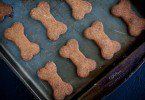To help prevent health concerns in your dog, it’s a good idea to get into the habit of checking your dog regularly for any changes or signs of illness. When checking your dog, it’s important to be vigilant, as your dog can’t tell you if they are feeling unwell. If you notice anything out of the ordinary, contact your vet right away.
To help keep your dog healthy, we’ve put together an easy to follow checklist.
Health checklist
- Body condition– You should just be able to feel the ribs and no more. There should be a waist between your dog’s ribs and hips and the belly should not sag. Watch for signs of weight loss or gain.
- Ears– Should be clear of any thick brown or green wax and have no smell. Some long-eared breeds benefit from regular ear cleaning with special ear cleaners. Be careful what you use to clean the ears, the skin in this area can be very sensitive. And don’t clean too deeply or vigorously, as the eardrum can be easily perforated.
- Eyes– Should be bright and clear, with no signs of runniness, redness or soreness. Your dog should not shy away from light as if it hurts the eyes. Eye problems can sometimes be accompanied by flu symptoms.
- Nose– There should be no crusting on the surface, runny discharges or bleeding. Noses can change from black to pink and back again, something that can vary through the year. The nose being cold or wet has no correlation to illness.
- Breath– Bad Breath is not just a cosmetic or social problem (we all know dogs with bad breath can be less-than-pleasant company). Bad breath can indicate a digestive problem or bad teeth, which could potentially lead to organ problems if left untreated. To find out more about combating bad breath, view Supercoat Dental Chews.
- Oral hygiene– Teeth should be white with no excess tartar, which looks thick and brown. The gums should be pink or black, not red or swollen. To find out more about improving oral hygiene, view Supercoat Dental Chews.
- Skin and coat– Your dog’s skin can be pink or black, depending on the pigments normally found in the breed. The coat should be healthy and shiny with no broken hairs. And both should be free of any scruffy dandruff or sores. Hair can be shed all year round, but it’s normally worse in summer and autumn so you’ll need a good vacuum cleaner. Some breeds like poodles don’t shed, although they need clipping regularly.
- Nails– Should be smooth and can be white or black. Nails that are roughened and break easily may require attention. When checking the nails, remember the dewclaws found on the inside of the leg just below the wrist. Some dogs have them on the front legs only; some have them front and back; and some don’t have any at all.
- Digestion– Keep an eye on your dog’s appetite for any noticeable changes. This can be very difficult to tell if the dog is new to you or a very fussy eater. There should be no sickness or choking when eating. Stools should be a normal colour with no diarrhoea, constipation or mucus (clear jelly) passed.
- Thirst– If your dog suddenly becomes thirsty or starts drinking more than usual, consult your vet.
- Attitude– Your dog’s general attitude to life can tell you a lot. If you notice that his head and tail are down, it usually means your dog is feeling under the weather. Poorly dogs can also skulk in corners, or even dig holes in the garden to lie in. If you’re worried, ask your vet for advice.
It is important to be aware of your dog’s health and happiness, so keep an eye on them and, if in doubt, consult a vet.








